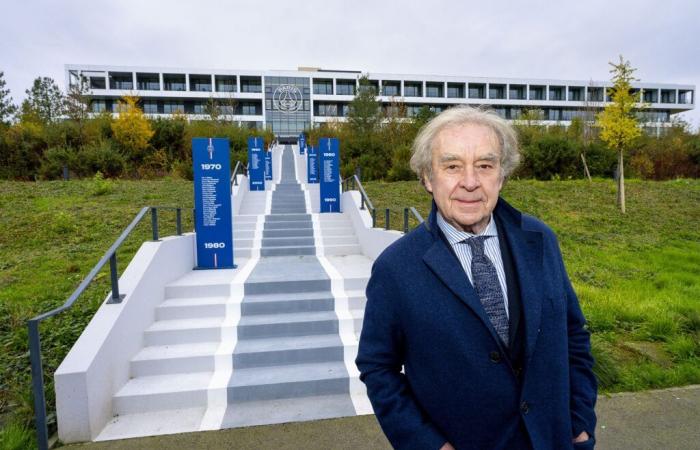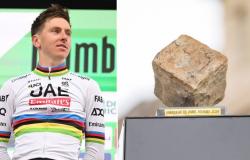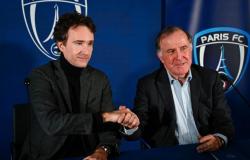The French architect has designed the brand new PSG training center which will be inaugurated this Thursday, November 21. The 59-hectare site required more than three years of work and 300 million euros of investment.
Goodbye Camp des Loges, long live the PSG Campus! After more than half a century spent in the famous training center of Saint-Germain-en-Laye, the capital club has decided to move its headquarters ten kilometers further west, to neighboring Poissy. For the first time in the history of PSG, the site will bring together the men's and women's squad as well as the 140 young shoots from the training center. Author of this modest 59-hectare jewel, Jean-Michel Wilmotte provides a showcase unique in Europe where sports facilities coexist with large green spaces. Nearly 4,000 trees and more than a million perennials make up the picture of an ultra-modern football-style campus which includes three areas – one dedicated to each team –, 16 football fields and 150,000 square meters dedicated to training. The center also hosts a middle school, a high school (95% bac pass rate) and even a 3.5 hectare organic vegetable garden which supplies a large part of the menus offered to players. A pharaonic project in which the French architect has been involved since 2016.
The rest after this ad
Paris Match: The PSG Campus is inaugurated this Thursday, November 21 after three years of work. What does the outcome of this project represent?
The rest after this ad
Jean-Michel Wilmotte: It is the fruit of a long work which began in July 2016 when we responded to the call for tenders launched by PSG. We won it in 2017 and the following year, we submitted the first building permits. In all, around twenty people from the Wilmotte&Associés agency participated in the different stages of the life of this infrastructure.
The rest after this ad
The rest after this ad
How did your project differ from your competitors?
It seems to me that what PSG liked was the way we thought about their training center and how we included it in its ecosystem. Reflection drives our architectural design and it was not just a question of creating a factory of champions but of bringing meaning to it.
In what way?
The PSG Campus was designed with the idea of putting nature at the center of the project. It is moreover the topographical characteristics of the site which determined what it would ultimately become. There is a 30 meter difference in height between each end of the land, the equivalent of a Haussmann building including the roof. It's huge. To best deal with this contingency, we then came up with the idea of taking a few liberties with the initial pitch desired by the club.
What was the basic idea?
The club's management wanted to build a training center dedicated to its football sector, capable of accommodating all its men, women and training center staff combined with all the characteristics of this type of structure. From then on, there were two possible paths: build a vast complex bringing together all the functions of the project – which, given the difference in altitude, would have forced us into a form of somewhat jumbled gigantism – or else split them up into platforms distinct. One dedicated to girls, one to boys and one for young people. From there, the idea for the campus was born. We thought of these plateaus as small villages connected by major roads allowing residents to move from one to the other and converging towards a central and symbolic place, the Campus House.
The building dedicated to Ligue 1 players is located on the highest part of the field. Was this a desire on your part?
Absolutely. As soon as we took the first tour of the site, back when it was just a big expanse of greasy mud, I said, “The pros will be here!” “. It seemed obvious to me. I find the symbolism very strong for the 13 year olds who join the training center. They dream of becoming professional, look up to the sky and see the professional building in the distance and high up. It's like the village bell tower. And they say to themselves: “Me too, one day, I will be there!” “. But we had to convince management because at the time, they saw things a little differently. Instead, she wanted to install the pros below. In this type of adventure, nothing is ever set in stone, everything evolves over the course of discussions. We had to take ownership of the project, understand the needs of the staff, lead them on paths they had not thought of and show them all the tools they would have at their disposal. It was a real exchange on both sides.
After the Allianz Riviera stadium in Nice that you built in 2013, you are reconnecting with the world of football. Have you visited other training centers to get an idea of the standards of the genre?
We went all over Europe. In Turin, Madrid and Manchester in particular. And what struck me was the degree of perfectionism of each site. But also, their lack of space! They are all cramped. At the time of the construction of these training centers, the question of expansion was not sufficiently anticipated and this is why the PSG Campus was designed as a modular site which can still extend between 30 and 40% of its surface area in the future. True luxury is space and this is what we also wanted to establish in each building. The goal was to prevent players from just stopping by for training and then leaving. We wanted to create a space where they feel at home, an ecosystem that keeps them on site and where they can come with their family.
Green spaces represent an important part of the PSG Campus. They cover thirty hectares…
It was essential that the training center was one with its local environment, that it blended in with the Marly forest which bordered it. In all, 208 different varieties of trees, shrubs and plants were used throughout the site with particular care given to harmony. If you look into the distance, you can't make out where the campus ends and the neighbors' land begins. This is what I call a seam: that is to say, we took part of the exterior and incorporated it into the site. And over time, it will become more patina because the plant will take on another 3-4 meters and integrate even more into the panorama.
The interior of each building is very refined, unlike what one might imagine for a football club of the standing of PSG…
The objective was space and light. To reinforce this feeling, we played on the heights without doing anything extravagant. It's sober and the luxurious character lies in the dimension of things. All interiors are made with wood, concrete and steel. No shiny or flashy material. The challenge was also to demonstrate that we could build the building for professionals, girls and young people with the same materials.






